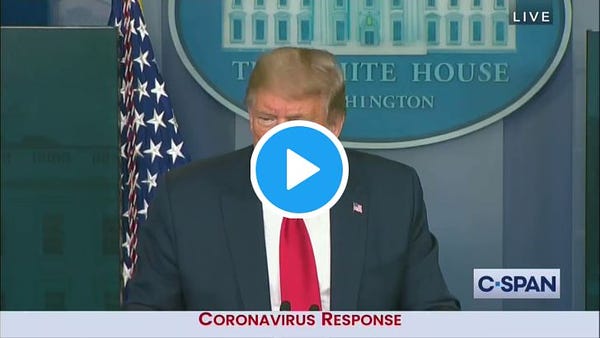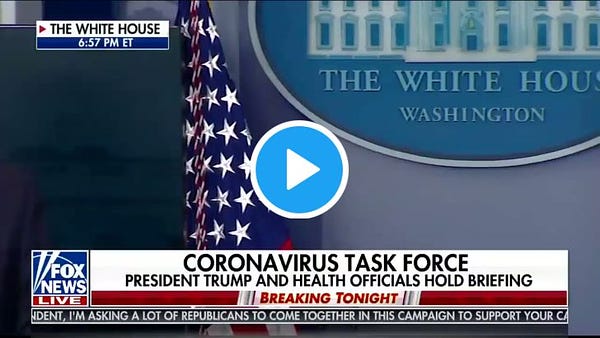April 13, 2020
It might be fair to say that today’s events started on Saturday, when the New York Times published an in-depth examination of “Trump’s Failure on the Virus,” with the heading: “He Could Have Seen What Was Coming.” Six reporters dug into emails, interviews, documents, and reports to reveal that “the president was warned about the potential for a pandemic” beginning in January, “but that internal divisions, lack of planning and his faith in his own instincts led to a halting response.”
Also this weekend, Trump vowed to “reopen” the country, despite warnings from his public health advisors that ending measures to slow the rate of coronavirus infection could be deadly. He is eager to restart the economy, the health of which he sees as key to his reelection, by May 1. On Sunday night, he tweeted: "Governors, get your states testing programs & apparatus perfected. Be ready, big things are happening. No excuses! The Federal Government is there to help. We are testing. More than any country in the World. Also, gear up with Face Masks!" (We are not testing more than any country in the world.)
But while the president can order federal workers back to their jobs, decisions about state closures and public health belong to state governments, not the president, and state governors have been saying so. This morning, Trump tweeted: “For the purpose of creating conflict and confusion, some in the Fake News Media are saying that it is the Governors decision to open up the states, not that of the President of the United States & the Federal Government. Let it be fully understood that this is incorrect…. It is the decision of the President, and for many good reasons.” He has said that he would announce his “Opening the Country” economic task force Tuesday.
Alarmed at Trump’s repeated insistence that the nation needs to end the physical distancing that has slowed Covid-19, state governors on both the east and west coasts announced today they have made pacts to work as a unit to manage the return to normalcy “in a safe, strategic, responsible way,” based on facts and science, as California Governor Gavin Newsom put it. New York, New Jersey, Pennsylvania, Delaware, Rhode Island, and Connecticut in the East, and California, Washington, and Oregon in the West, have agreed to cooperate, and they have invited other states to join them.
This was a huge shot across Trump’s bow. He repeatedly told governors they were on their own to manage the coronavirus then set up a system in which the federal government often seized their supplies when they tried to do so. Last week, Newsom made it clear he was through trying to work with Trump. He referred to California as a nation-state and suggested he would work with other states to get medical supplies. Now states are organizing to operate without the president.
When he gave his briefing today, Trump was visibly angry at both the New York Times story and at the governors’ pact. He began by playing a video for the reporters that celebrated his handling of the coronavirus crisis and blamed the media for downplaying the seriousness of the pandemic in its early days. CBS News reporter Paula Reid pointed out “Your video had a complete gap. What did your administration do in February…?” She refused to let up. He called her fake. With 23,000 Americans dead from the coronavirus—that have been officially counted; many more are dying without an official diagnosis—Trump refused to admit he had made a single mistake. Instead, he blamed his predecessor, President Barack Obama, for the lack of masks in the strategic national stockpile and the lack of testing kits and insisted, “I saved tens of thousands, maybe hundreds of thousands of lives.”
Then he took on the question of whether he or the governors got to reopen the states. Trump repeatedly asserted that right was his, and his alone. “When somebody is President of the United States,” Trump said, “the authority is total.” When a reporter asked what provisions of the Constitution gives the president the power to open or close state economies, he could not name one, but answered: “Numerous—numerous provisions. We can give you a legal brief if you want.” “The federal government has absolute power. It has the power. As to whether or not I'll use that power -- we'll see ... I have the absolute right if I want to.” Trump's repeated assertion of dictatorial power actually sounded desperate to me, as if he were trying to regain control of the governors. Trump does not, in fact, have the power to do anything he is asserting, and his bluster will not hold up unless the governors relent. Trump repeatedly emphasized that he had a great relationship with the state governors, and was hoping to be able to work with them.
There were other bad signs for the president today, too. The evening before last week’s election in Wisconsin, the US Supreme Court ruled that the election must go forward despite the fact that many absentee ballots had not been delivered and that the virus had forced closures of the majority of polling places in Democratic districts. At stake was a contested seat on the Wisconsin Supreme Court, which will be deciding a key voter suppression case before the 2020 election. Wisconsin Republicans had worked hard to tilt the playing field to throw the election to their candidate. They failed. The Republican incumbent Daniel Kelly, appointed by Republican Governor Scott Walker and endorsed by Trump, lost badly to Democratic challenger Jill Karofsky. While the court will keep its conservative majority, Karofsky will likely help to kill the voter suppression measure. The triumph of a Democrat in this election, despite all the efforts to rig it, should worry Trump.
So should the fact that Vermont Senator Bernie Sanders today endorsed former Vice President Joe Biden for president. Sanders will have gotten concessions from Biden just as other candidates did, which should help the process of building a broad coalition for the Democrats in 2020. Also troublesome for the Republicans in 2020 is that Virginia Governor Ralph Northam has signed laws to expand voting in his state. Higher voting numbers help Democrats. "Voting is a fundamental right, and these new laws strengthen our democracy by making it easier to cast a ballot, not harder," Northam said. "No matter who you are or where you live in Virginia, your voice deserves to be heard."
The Supreme Court announced today it will hear the cases concerning Trump’s finances after all. The justices were supposed to hear oral arguments in March on the question of whether the president and his financial advisors must obey subpoenas from the House of Representatives and a New York prosecutor. Trump is arguing that a president cannot be investigated for criminal activity while in office. The case got postponed by the pandemic, but it’s now back on the table.
And finally, today NPR followed up the New York Times article with an investigation of how successful Trump has been in fulfilling the promises he made a month ago when he declared a national emergency to fight the spreading infections. It concluded that those promises were largely unfilled. Tonight the White House responded to the story, saying that the president had taken “bold and decisive actions” to lead the fight against the coronavirus pandemic.
—-
You can sign up for this free newsletter at heathercoxrichardson.substack.com
—-
Notes
https://www.nytimes.com/2020/04/11/us/politics/coronavirus-trump-response.html
Trump reopening: https://www.cnn.com/2020/04/13/politics/donald-trump-coronavirus-economy-testing/index.html
States working together: https://www.cnn.com/2020/04/13/politics/states-band-together-reopening-plans/index.html
https://www.gov.ca.gov/2020/04/13/california-oregon-washington-announce-western-states-pact/
Briefing:


https://www.cnn.com/2020/04/13/politics/fact-check-coronavirus-briefing-april-13/index.html
https://www.cnn.com/2020/04/13/politics/supreme-court-cases-teleconference/index.html
Virginia: https://www.cnn.com/2020/04/12/politics/virginia-election-day-holiday-early-voting/index.html



